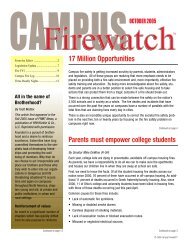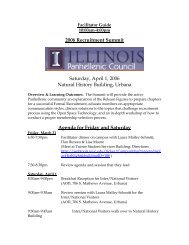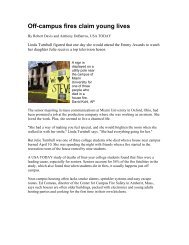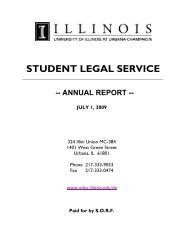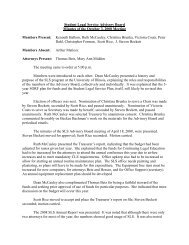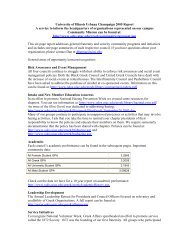StudentAffairsRole in Assessment - Office of the Dean of Students ...
StudentAffairsRole in Assessment - Office of the Dean of Students ...
StudentAffairsRole in Assessment - Office of the Dean of Students ...
You also want an ePaper? Increase the reach of your titles
YUMPU automatically turns print PDFs into web optimized ePapers that Google loves.
<strong>in</strong>tellect curiosity challenge create achievement connection self-reflection educate action understand communicate listen learn access qualit<br />
<strong>in</strong>novation success <strong>in</strong>genuity <strong>in</strong>tellect curiosity challenge knowledge accountability connection understand communicate listen learn access qualit<br />
<strong>in</strong>novation success <strong>in</strong>genuity self-reflection educate action understand <strong>in</strong>tellect knowledge accountability connection self-reflection educate actio<br />
understand communicate curiosity challenge create achievement connection self-reflection curiosity challenge create achievement connection sel<br />
reflection knowledge accountability connection self-reflection educate action understand communicate listen learn access quality <strong>in</strong>novation succes<br />
<strong>in</strong>genuity <strong>in</strong>tellect curiosity challenge educate <strong>in</strong>novation success <strong>in</strong>genuity <strong>in</strong>tellect curiosity challenge create achievement knowledge accountabilit<br />
connection self-reflection educate action understand communicate curiosity challenge create achievement connection self-reflection understan<br />
communicate listen learn access quality action educate action understand communicate listen learn action understand communicate listen learn acces<br />
E n d n o t e<br />
A Historical Review <strong>of</strong> <strong>Assessment</strong> <strong>in</strong> Student Affairs Through Selected Sem<strong>in</strong>al<br />
Documents<br />
Over a period <strong>of</strong> nearly eight decades, <strong>the</strong> contributions <strong>of</strong> student affairs to student learn<strong>in</strong>g have evolved from a<br />
peripheral to a central role. Similarly, assessment <strong>in</strong> student affairs has evolved, with chang<strong>in</strong>g perspectives about<br />
how student affairs <strong>of</strong>fices and programs contribute to student life and how that contribution can best be assessed.<br />
While <strong>the</strong> first student personnel dean was appo<strong>in</strong>ted <strong>in</strong> 1890 (Rhatigan, 2009, cit<strong>in</strong>g Cowley, 1937), it was not<br />
until 1937 that student affairs became a more permanent, formal feature <strong>of</strong> higher education <strong>in</strong> <strong>the</strong> United States<br />
(see The Student Personnel Po<strong>in</strong>t <strong>of</strong> View, 1937 [NASPA, 1989]). The student affairs pr<strong>of</strong>ession has shifted from<br />
1937 to now, so as to critically address not only <strong>the</strong> student’s <strong>in</strong>tellectual development but <strong>the</strong> student’s personal<br />
development as well. Student affairs pr<strong>of</strong>essionals take various roles on campuses, among <strong>the</strong>m advis<strong>in</strong>g, career<br />
counsel<strong>in</strong>g, and orient<strong>in</strong>g students to <strong>the</strong>ir colleges. While assessment has not been among <strong>the</strong> functions <strong>of</strong><br />
student affairs for <strong>the</strong> entirety <strong>of</strong> <strong>the</strong> pr<strong>of</strong>ession, evaluat<strong>in</strong>g and understand<strong>in</strong>g programs and <strong>the</strong>ir usefulness to<br />
students has been a foundational element <strong>of</strong> <strong>the</strong> student affairs purpose, as shown <strong>in</strong> sem<strong>in</strong>al pr<strong>of</strong>essional statements.<br />
Not until around 1949 did student affairs <strong>of</strong>fices beg<strong>in</strong> to be acknowledged for <strong>the</strong>ir role <strong>in</strong> student learn<strong>in</strong>g (see<br />
The Student Personnel Po<strong>in</strong>t <strong>of</strong> View, 1949 [NASPA, 1989]). Learn<strong>in</strong>g experiences provided by student affairs<br />
were considered to be extracurricular—mean<strong>in</strong>g outside <strong>of</strong> <strong>the</strong> formal course <strong>of</strong> study <strong>in</strong> which students were<br />
engaged—and student affairs staff began to connect <strong>the</strong>se experiences with <strong>the</strong> total experience <strong>of</strong> <strong>the</strong> students’<br />
collegiate life through a focus on evaluation and cont<strong>in</strong>uous improvement (p. 44).<br />
In 1987 student affairs pr<strong>of</strong>essionals reflect<strong>in</strong>g on <strong>the</strong>ir role <strong>in</strong> colleges and universities released a document to<br />
publicize what should be expected <strong>of</strong> student affairs <strong>of</strong>fices on campuses, plac<strong>in</strong>g <strong>the</strong>ir role <strong>in</strong> student learn<strong>in</strong>g as<br />
central to <strong>the</strong> purpose <strong>of</strong> student affairs (NASPA, 1987). The field was challenged to go beyond provid<strong>in</strong>g services<br />
for students and supervis<strong>in</strong>g <strong>the</strong> social activities <strong>of</strong> students by becom<strong>in</strong>g collaborators with academic affairs <strong>in</strong><br />
provid<strong>in</strong>g learn<strong>in</strong>g experiences for students. In addition to <strong>the</strong> major publications that document <strong>the</strong> shift<strong>in</strong>g trends<br />
<strong>in</strong> student affairs, scholars began to support <strong>the</strong> assertion that student affairs plays a major role <strong>in</strong> students’ development<br />
on campuses, with cocurricular activities hav<strong>in</strong>g significant mean<strong>in</strong>g (Kuh et al., 2005/2010; Pascarella<br />
& Terenz<strong>in</strong>i, 1991, 2005). Pr<strong>of</strong>essional organizations also supported <strong>the</strong> chang<strong>in</strong>g role <strong>of</strong> student affairs and<br />
its importance to <strong>the</strong> student collegiate experience, as expressed <strong>in</strong> <strong>the</strong> ACPA publication, The Student Learn<strong>in</strong>g<br />
Imperative: Implications for Student Affairs (1996), and <strong>the</strong> American Association for Higher Education (AAHE),<br />
NASPA, and ACPA publication, Powerful Partnerships: A Shared Responsibility for Student Learn<strong>in</strong>g (1998). Advocat<strong>in</strong>g<br />
assessment as <strong>the</strong> important function <strong>in</strong> advanc<strong>in</strong>g student learn<strong>in</strong>g, <strong>the</strong>se documents reflected <strong>the</strong> common<br />
conceptions <strong>of</strong> student affairs at <strong>the</strong> time.<br />
By 1999, conceptualizations <strong>of</strong> <strong>the</strong> roles and contributions <strong>of</strong> student affairs <strong>in</strong>cluded learn<strong>in</strong>g and assessment <strong>of</strong><br />
learn<strong>in</strong>g—with “[g]ood practice <strong>in</strong> student affairs [occurr<strong>in</strong>g] when student affairs educators ask, ‘What are students<br />
learn<strong>in</strong>g from our programs and services, and how can <strong>the</strong>ir learn<strong>in</strong>g be enhanced’” (Bliml<strong>in</strong>g, Whitt, & Associates,<br />
1999, pp. 206–207). By tak<strong>in</strong>g this question seriously, student affairs educators were encouraged to assess students’<br />
learn<strong>in</strong>g and to use this assessment <strong>in</strong>formation to revise programs for both student and <strong>in</strong>stitutional improvement.<br />
Ano<strong>the</strong>r pr<strong>in</strong>ciple, articulated <strong>in</strong> Good Practice <strong>in</strong> Student Affairs: Pr<strong>in</strong>ciples to Foster Student Learn<strong>in</strong>g (Bliml<strong>in</strong>g et<br />
al., 1999), had to do with measur<strong>in</strong>g <strong>the</strong> effectiveness <strong>of</strong> programs and services: “Good practice <strong>in</strong> student affairs<br />
occurs when student affairs educators ask, ‘What are students learn<strong>in</strong>g from our programs and services, and how<br />
can <strong>the</strong>ir learn<strong>in</strong>g be enhanced’” (pp. 206–207). Moreover, <strong>in</strong> def<strong>in</strong><strong>in</strong>g <strong>the</strong> role <strong>of</strong> student affairs staff, <strong>the</strong> authors<br />
assert, “Student affairs educators who are skilled <strong>in</strong> us<strong>in</strong>g assessment methods acquire high-quality <strong>in</strong>formation;<br />
effective application <strong>of</strong> this <strong>in</strong>formation to practice results <strong>in</strong> programs and change strategies that improve <strong>in</strong>stitutional<br />
and student achievement” (p. 207). The publication <strong>of</strong> this sem<strong>in</strong>al document advanced student affairs<br />
practice to where it is today: focus<strong>in</strong>g on how to develop programs, experiences, and activities that contribute to<br />
student learn<strong>in</strong>g—and also provid<strong>in</strong>g evidence <strong>of</strong> this contribution.<br />
National Institute for Learn<strong>in</strong>g Outcomes <strong>Assessment</strong> | 15



